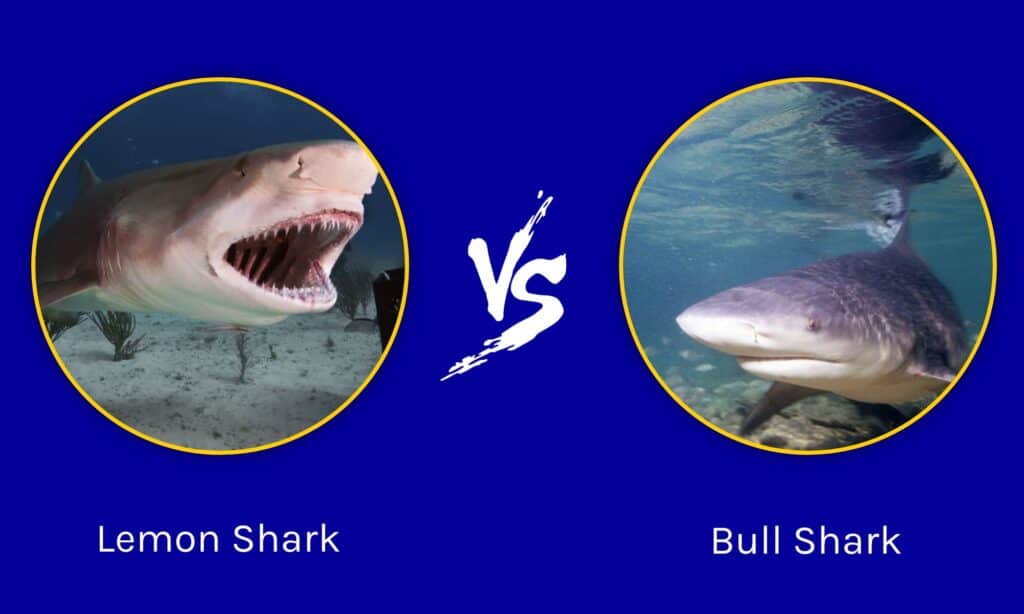Sharks often get lumped together despite there being thousands of unique species across the world. A common example of this occurrence is the lemon shark and the bull shark. Although these fish are quite different in a lot of ways, their overlapping distribution and somewhat similar appearance often have them being mistaken for one another. Today, we are going to compare them to see what makes them unique. Let’s discover: Lemon Shark vs Bull Shark; why are they different? Let’s get started!
Comparing a Lemon shark and a Bull shark

| Lemon shark | Bull shark | |
|---|---|---|
| Size | Length: 8-10 feet Weight: 200-420 lbs | Length: 7-11 feet Weight: 200-500 lbs |
| Appearance | Yellow-tinged for camouflage on sandy floors. Typical shark build. | Grey bodies with white underbelly. Typical shark build but with stocky head. |
| Social structure | Diverse social structure. Usually lives in groups. | Usually solitary, but occasionally groups to hunt. |
| Distribution | Coastal waters in the Western Hemisphere. | Tropical waters worldwide. |
| Freshwater tolerance | No freshwater tolerance. | Complete freshwater tolerance for extended periods. |
| Attacks on humans | No known human fatalities, 10 total bites. | One of the three deadliest sharks by the numbers. |
The 6 main differences between a lemon shark and a bull shark
The main differences between lemon sharks and bull sharks are their appearance, freshwater tolerance, and varying distribution.
Lemon and bull sharks are both relatively equal in size and, at first glance, somewhat similar in appearance. As their name suggests, lemon sharks are known for their yellow-tinged bodies. This yellow tinge allows them to coast along sandy floors and remain camouflaged. Bull sharks get their names from their tendency to bump prey targets before biting them, although their appearance is stockier than that of the lemon shark. Additionally, bull sharks are only grey and white, not yellow.
Aside from appearances, lemon sharks and bull sharks have varying social structures. Lemon sharks are a species of shark known for their large communal groups, a rarity for many predators. When able, lemon sharks live in loose aggregations, with most individuals being roughly the same size within the groups. This benefits the sharks in terms of mating potential and hunting outcomes. Bull sharks are not communal sharks, however. They are generally seen in isolation, although some instances of bull sharks teaming up to hunt certain prey are documented.
Let’s take a look at these differences, plus a few more, in some more detail below!
Lemon Shark vs Bull Shark: Size

Both sharks are similar in size, although bull sharks can theoretically get larger.
©Michael Bogner/Shutterstock.com
Both the lemon and bull shark are extremely similar in average size. Lemon sharks generally measure 8-10 feet long and weigh 200-420 lbs, although some individuals can get larger. This species is sexually dimorphic, with the females being larger than the males.
Bull sharks have a similar average size when compared to the lemon shark, but there are more documented cases of exceptional individuals. On average, bull sharks measure 8-11 feet long and weigh 200-500 lbs. Still, documented cases of bull sharks exceeding 700 and even 800 lbs do exist.
Lemon Shark vs Bull Shark: Appearance

Lemon sharks are yellow-tinged, and bull sharks are grey and white.
©Willyam Bradberry/Shutterstock.com
Bull sharks also have the standard “shark” look that most are familiar with and come in the typical grey and white. Where the lemon shark is slim and streamlined, the bull shark is thick and stocky. Additionally, their snouts are short and stubby, and quite distinct.
The lemon shark gets its name from its unique coloring. These sharks have most of the standard features people come to expect in a shark, but instead of the typical gray shading, lemon sharks are tinged yellow. This yellow tinging is an adaptation to the coastal environments that these sharks live in, allowing them to cruise along sandy floors with near invisibility.
Lemon Shark vs Bull Shark: Social structure

Lemon sharks group with other lemons.
©Greg Amptman/Shutterstock.com
One of the unique aspects of the lemon shark is its tendency to group together. A few species of shark exhibit this behavior, and the lemon shark is among them. These groups are usually made up of similar-sized individuals. The social structure of the lemon shark allows for greater mating potential and higher hunting success, with many groups even having their own internal hierarchy.
Bull sharks are generally recognized as solitary hunters. They are seen in isolation, but some instances of bull sharks teaming up to hunt specific prey have been documented. Still, their social structure isn’t anything significant when compared to the lemon shark.
Lemon Shark vs Bull Shark: Distribution

Bull sharks are found in tropical waters globally.
©Carlos Grillo/Shutterstock.com
The lemon shark is a tropical shark that lives along the coasts in the Western Hemisphere. It can be found along the eastern and western coasts of North, Central, and South America, plus the western coast of Africa.
Bull sharks are extremely widespread, although they prefer the same habitat as the lemon shark. You can find bull sharks in nearly every coastal tropical region globally.
Lemon Shark vs Bull Shark: Freshwater tolerance

Lemon sharks do not have freshwater tolerance.
©Yann hubert/Shutterstock.com
Like most sharks, lemon sharks don’t have any freshwater tolerance. They require saline water (ocean water) to survive, and freshwater would be fatal.
Bull sharks are incredibly resilient sharks and are known for their freshwater tolerance. In North America, they have been seen up the Mississippi as far as St. Louis. In South America, bull sharks have been documented deep into the Amazon, thousands of miles away from the ocean.
Lemon Shark vs Bull Shark: Attacks on humans

Bull sharks are the third most deadly species.
©Carlos Grillo/Shutterstock.com
Lemon sharks aren’t known to intentionally attack humans. There are roughly ten documented lemon shark attacks, none of which were fatal.
Bull sharks are known as one of the “big 3” sharks in terms of attacks on humans, behind the great white and tiger sharks. Still, as scary as they are, there have only been 121 total instances of bull shark attacks, with only 26 being fatal.
The photo featured at the top of this post is © Willyam Bradberry/Shutterstock.com
Thank you for reading! Have some feedback for us? Contact the AZ Animals editorial team.






